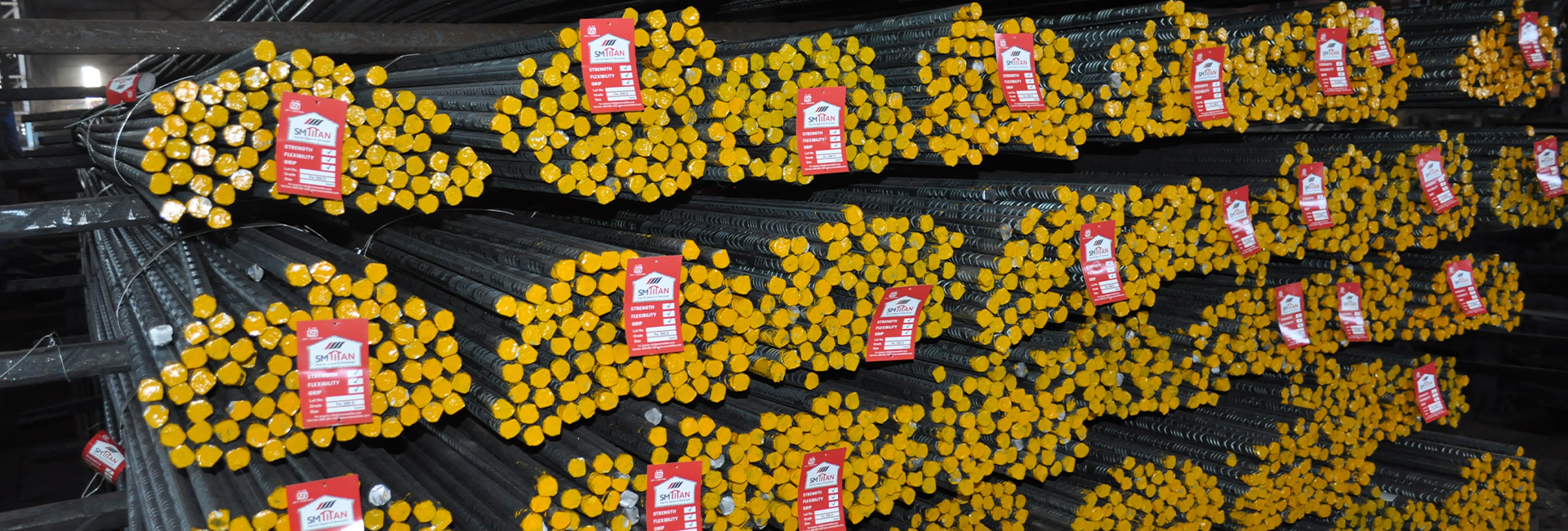In the construction industry, the choice of reinforcement bars (rebars) plays a crucial role in determining the strength, safety, and longevity of structures. Among the various types of reinforcement bars available, TMT (Thermo-Mechanically Treated) bars and TMX (Thermo-Mechanically Extra) bars are widely used due to their enhanced properties. While both TMT and TMX bars are designed to meet the rigorous demands of modern construction, they have distinct features and advantages. This essay provides a comparative analysis of TMT and TMX bars, focusing on their properties, benefits, applications, and suitability for various construction scenarios.
|
Table of Content
|
Overview of TMT Bars
TMT bars are manufactured using a thermomechanical treatment process that involves three stages: quenching, self-tempering, and atmospheric cooling. This process results in bars with a strong outer surface and a ductile core. The unique combination of strength and ductility makes Sree Metaliks TMT bars ideal for reinforcing concrete structures in residential, commercial, and infrastructure projects.
Key Properties of TMT Bars:
- High Tensile Strength: TMT bars possess high tensile strength, which enables them to withstand substantial loads and resist deformation under stress.
- Ductility and Flexibility: The soft core of TMT bars allows them to bend without breaking, making them suitable for regions prone to seismic activity.
- Corrosion Resistance: TMT bars have low carbon content and are often treated with anti-corrosive coatings, enhancing their resistance to rust and corrosion.
- Earthquake Resistance: The flexibility and ductility of TMT bars enable them to absorb and dissipate seismic energy, reducing the risk of structural failure during earthquakes.
- Weldability: The low carbon content also ensures excellent weldability, allowing the bars to be easily joined during construction.
TMT bars are classified into different grades of steel bars based on their strength, including Fe-415, Fe-500, Fe-550, and Fe-600, with Fe-500 being the most commonly used grade in construction.
Overview of TMX Bars
TMX bars, also known as Thermo-Mechanically Extra bars, are an advanced version of TMT bars. They are produced using a specialized German technology called "Thermex," which results in bars with enhanced mechanical properties. TMX bars are engineered to provide better performance in critical construction applications where superior strength and durability are required.
Key Properties of TMX Bars:
- Higher Strength and Toughness: TMX bars are known for their higher yield strength compared to conventional TMT bars. They offer improved load-bearing capacity, making them suitable for heavy-duty construction.
- Superior Bonding with Concrete: TMX bars have better rib patterns and surface finish, which result in improved bonding with concrete. This enhances the overall strength of the reinforced structure.
- Improved Corrosion Resistance: TMX bars are designed to resist corrosion more effectively, even in environments with high humidity or salinity.
- Better Fatigue Resistance: The Thermex process imparts enhanced fatigue resistance to TMX bars, making them more durable under cyclic loading conditions.
TMX bars are typically available in grades such as Fe-500D and Fe-550D, which are preferred for high-rise buildings, bridges, dams, and other critical infrastructure projects.
Also Read: Step-by-Step Guide to Calculating Steel Quantity
Comparative Analysis: TMT Bars vs. TMX Bars
-
Manufacturing Process:
- TMT Bars: The thermomechanical treatment process involves rapid quenching, self-tempering, and atmospheric cooling, resulting in a composite structure with a hard outer layer and a ductile core.
- TMX Bars: The Thermex process used in TMX bar production involves controlled water cooling, followed by tempering and natural cooling. This specialized process gives TMX bars enhanced strength and mechanical properties compared to regular TMT bars.
-
Strength and Durability:
- TMT Bars: TMT bars offer excellent strength and are available in various grades like Fe-415, Fe-500, and Fe-600. They provide adequate durability for most construction applications.
- TMX Bars: TMX bars have higher yield strength and tensile strength compared to TMT bars, making them more suitable for high-stress applications. Their enhanced toughness ensures better performance in demanding conditions like heavy loads and vibrations.
-
Corrosion Resistance:
- TMT Bars: TMT bars have low carbon content and are often coated with anti-corrosive materials to resist rusting. They are effective in environments where corrosion is a concern but may still require additional protection in highly corrosive settings.
- TMX Bars: TMX bars offer superior corrosion resistance due to their specialized manufacturing process and material composition. They are better suited for construction in coastal regions or areas with high humidity and salinity.
-
Ductility and Flexibility:
- TMT Bars: The ductile core of TMT bars provides excellent flexibility, making them ideal for structures in earthquake-prone zones. Their ability to bend without breaking enhances their earthquake resistance.
- TMX Bars: TMX bars are also ductile, but their primary advantage lies in their higher strength. While they maintain adequate flexibility, they are designed to prioritize load-bearing capacity over extreme bending.
-
Weldability:
- TMT Bars: The low carbon content in TMT bars ensures good weldability, allowing them to be easily joined during construction without compromising strength.
- TMX Bars: TMX bars also offer good weldability, though their higher strength may require more careful handling during welding processes to avoid weakening the joints.
-
Bonding with Concrete:
- TMT Bars: TMT bars have ribbed surfaces that provide adequate bonding with concrete, ensuring a strong composite structure. However, the rib pattern and surface finish of TMT bars can vary based on the manufacturer.
- TMX Bars: TMX bars have optimized rib patterns and smoother surface finishes, resulting in superior bonding with concrete. This ensures better load transfer between the concrete and the reinforcement, enhancing overall structural integrity.
-
Applications:
- TMT Bars: TMT bars are widely used in residential and commercial construction, infrastructure projects, and structures like roads, bridges, and water tanks. They are versatile and suitable for a broad range of applications.
- TMX Bars: TMX bars are preferred for high-stress applications where enhanced strength, durability, and corrosion resistance are critical. They are commonly used in high-rise buildings, industrial structures, dams, flyovers, and other heavy-duty infrastructure.
-
Cost Considerations:
- TMT Bars: TMT bars are more affordable than TMX bars, and the competitive TMT bar price makes them a cost-effective choice for standard construction projects. The availability of TMT bars with different grades allows for flexibility in selecting the right bars based on specific budget and performance needs.
- TMX Bars: TMX bars are generally more expensive due to their superior properties and specialized manufacturing process. However, their long-term performance and durability can offset the initial higher costs, especially in critical projects.
-
Environmental Impact:
- TMT Bars: The production of TMT bars is relatively more energy-efficient compared to traditional steelmaking methods, contributing to a lower carbon footprint. Additionally, their recyclability enhances their environmental friendliness, making them a more sustainable option.
- TMX Bars: TMX bars are also environmentally friendly, with an emphasis on energy-efficient production methods. Their enhanced durability reduces the need for frequent repairs or replacements, further contributing to sustainability.
Also read: Why Choose TMT Bars for Your Dream Home?
Conclusion: Choosing Between TMT and TMX Bars
The choice between TMT and TMX bars depends on the specific requirements of the construction project. TMT bars are versatile, cost-effective, and suitable for a wide range of applications, from residential buildings to infrastructure. Their flexibility, weldability, and corrosion resistance make them an excellent choice for standard construction needs, particularly in earthquake-prone areas.
On the other hand, TMX bars are engineered for performance in demanding conditions. Their higher strength, improved bonding with concrete, and superior corrosion resistance make them ideal for critical infrastructure projects, high-rise buildings, and structures exposed to harsh environments. While they are more expensive, their enhanced durability and load-bearing capacity justify the investment in projects where long-term performance is paramount.
In summary, TMT bars are well-suited for general construction, offering a balance of strength, ductility, and affordability. TMX bars, with their advanced properties, are the preferred choice for specialized applications that demand higher performance and longevity. Understanding the differences between these bars allows engineers and builders to make informed decisions, ensuring that structures are safe, durable, and cost-effective.
For more information, please reach out to us at: Sales@sreemetaliks.com

